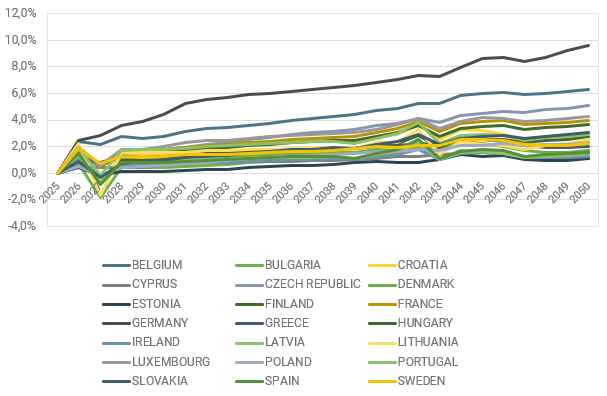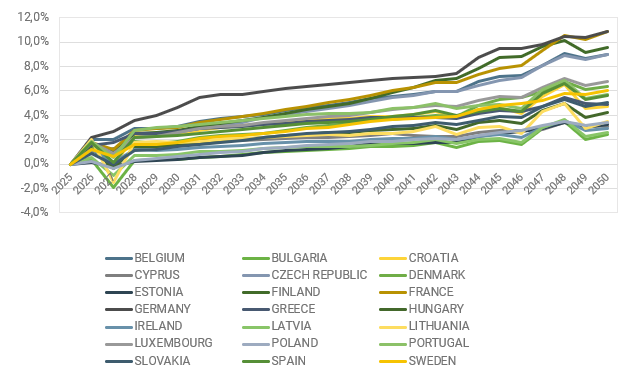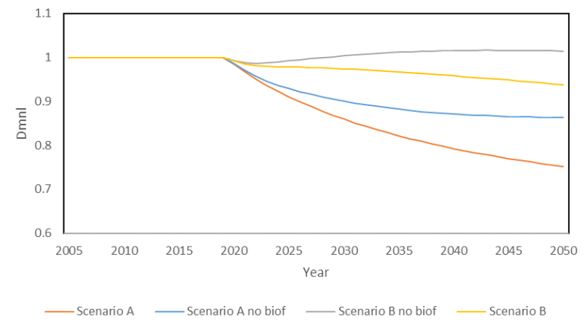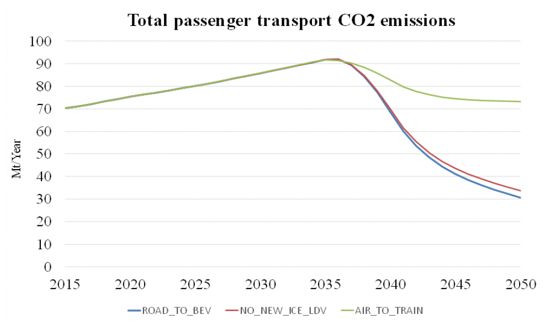Simulation results
LOCOMOTION has produced a set of sector-specific results from simulating the functional parts of the WILIAM model. Three of these results are presented here projecting the impact of different sets of policies on CO2 emissions, inequality or land use:
Reducing Passenger Travel Emissions in Spain:
3 Promising Policies
Introducing Basic Income in Europe:
Potential Benefits and Challenges
Increasing Biofuels Production
Land Competition with Food Production
For more details and the scenarios and results, consult the Recommendations report on policy and social behaviour.
Reducing Passenger Travel Emissions in Spain: 3 Promising Policies
This study explores the potential of different policies to cut greenhouse gas emissions (GHG) from passenger transport in Spain. Researchers used WILIAM to assess three scenarios:
- Ban on New Gas-Powered Cars by 2035: Aligning with the EU’s regulation, this policy focuses on phasing out new combustion engine cars.
- Full Electric Vehicle (EV) Shift by 2035: Taking a more ambitious approach, this scenario aims for complete electrification of all road vehicles (cars, motorbikes, buses) by 2035.
- Domestic Flights to High-Speed Rail by 2035: This policy explores replacing short-distance air travel with Spain’s extensive high-speed rail network.
Scenario definition:
The policies are applied on top of a baseline scenario which represents the evolution of the system that follows current trends and policies already in-place. In the scenario it is assumed that transport demand will increase with GDPpc and population from current 650 Gkm*person to around 900 Gkm*person, following historic trends. The additional demand will translate mostly into new private cars and increased air travel. The scenario models targets of the National Integrated Energy and Climate Plan (PNIEC 2021-2030) of increasing the total of electrified vehicles to 5 million (of which 3 million are passenger cars), with the share of battery electric and plug-in hybrid electric vehicles following historic trends. Regarding the percentage of RES in the electricity mix, an increase of +50% (from 37.5% in 2020 to 56.3% in 2030) has been assumed.
Significant GHG Reductions Potential:
The study found that all three policies hold promise for substantial GHG reductions. Policies 1 and 2, targeting road transport decarbonization, are projected to achieve the highest impact, with a combined potential of 70% reduction. While a ban on new gas-powered cars is effective, full EV adoption offers slightly greater emission reduction due to its broader scope (including motorbikes and buses). However, both options require significant investments in electric vehicles, batteries, and charging infrastructure and have large material and energy footprints. Policy 3, on the other hand, is a potentially cost-neutral policy, as the additional demand for high-speed rail transport can be absorbed with the existing fleet and train schedule.
A Step Towards Climate Goals:
The modelled policies offer valuable examples for reducing passenger transport emissions. However, the study emphasizes the need for a comprehensive approach combining multiple measures to achieve climate neutrality targets by 2050.
Basic Income in Europe: Potential Benefits and Challenges
The WILIAM model was used to simulate the effects of a basic income (BI) program in 21 European countries, considering two ways to fund it: a wealth tax and a profit tax. BI provides every citizen with a regular cash payment, regardless of employment status.
Scenario definition
The BI policy was modelled as a universal income equivalent to 10% of the annual average disposable income of each country starting from 2026, which is handed out to each household. Simulations run until 2050. The value of the BI varies according to the heterogeneity of income levels across European countries. The benefits simulated are not high enough to guarantee a complete substitute for labour income. The BI benefit evolves over time in each scenario, as the payments increase proportionally with the average disposable income.
Reducing Inequality and Boosting the Economy
The research highlights several key findings. First, BI is shown to be a powerful tool for reducing income inequality, as measured by the Gini index. Second, funding BI with wealth taxes (taxes on assets) proves more effective for tackling inequality and improving public finances than profit taxes. Finally, BI offers a moderate increase in GDP and employment, which comes at the cost of potentially higher emissions.
However, there’s a catch. The positive effects come with a potential rise in CO2 emissions due to increased consumption. To achieve climate neutrality, BI must be implemented alongside specific policies that target emission reduction.

CO2 emissions. BI financed through a wealth tax – relative difference with respect to the baseline scenario

CO2 emissions. BI financed through a profit tax – relative difference with respect to the baseline scenario
Note: Figures report the relative difference (percentual difference) of the scenarios with respect to the baseline scenario (without any policy).
Increasing Biofuels Production: Land Competition with Food Production
Using WILIAM, our researchers explored the potential competition arising between cultivating crops for biofuels and for food production. This competition has the potential to jeopardize food security, particularly in developing nations. Currently, biofuels represent a small portion of the world’s transportation fuel consumption, with most being first-generation biofuels derived from conventional food crops like corn, sugarcane, and soybean.
Scenario definition
To assess this potential impact, WILIAM was employed to estimate future biofuel production and its influence on crop availability under two distinct scenarios:
- Scenario A: This scenario assumes limitations on cropland expansion and modest increases in crop yields.
- Scenario B: This scenario allows for a 10% increase in cropland area by 2050 and assumes a 30% rise in crop yields by 2050 in industrialized agriculture regions.
Crop shortages due to biofuel production
The findings from both scenarios within the WILIAM model suggest that significant increases in biofuel production would lead to substantial crop shortages, even with modest improvements in crop yield. This competition is particularly severe for corn, where biofuel demand, according to the modelling results, can surpass food demand.

Global ratio of availability of crops (blue and grey lines: without the increase in biofuels’ demand, red and yellow lines: with the increase in biofuels’ demand)
The result emphasizes the importance of prioritizing food production over biofuels. To achieve this and mitigate the potential competition for land, advanced biofuels derived from non-food sources such as algae or agricultural residues should be further explored.

